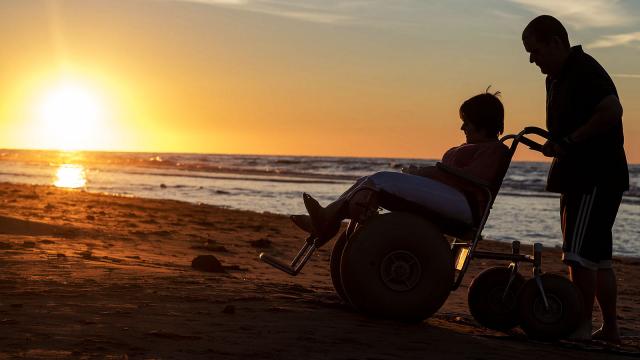The onset of a chronic disability brings a new perspective on accessibility.

I have a new perspective on life.
While I am waiting for two hip replacements, my mobility is decreasing – in direct proportion to the increase in chronic pain I am managing. These two factors, along with the long wait for joint replacement in the Ontario health care system, have come together in a perfect storm and for the first time in my life I find myself living with a chronic disability.
What I have to say will not be news for those who have lived with this for much longer than I have. And eventually I have every hope that I will be able to return to a reasonably active lifestyle. In the meantime this is what I have learned and what I hope I will remember as I look at the buildings, streets, and surroundings that make up the communities I live, work, and play in.
I look at accessibility from a new perspective. I look at the incline of ramps – not just whether there is a ramp –and the availability of handrails. I look at the height and number of steps. I look at how many people are heading in and out of buildings and whether, given the number of people, I can reach a handrail. I look at whether a bench is available along a walking route and what height it might be. Sometimes what I see means I can’t get into a particular building or space even when that building is labelled “accessible.”
I look at public transit differently. I consider whether I will be able to get a seat or not. I consider whether I can wait for transit sitting down or if I need to stand. I consider whether I can reach an escalator or elevator. The failure of any of those factors mean that more often than not I can’t use public transit.
I look at social and public events with a new eye. Will there be places to sit? If there is food, am I expected to carry it myself? Even more awkward if there a drink I would need to carry! And is it just the people I hang out with – or what is it with the social stand up? Standing for any period of time and my joints lock up, making it not only painful to stand but to move again. So I am careful what social events I go to.
What have I learned with this new perspective? I have learned:
- I am really bad at asking for help, but I am the only one who can tell people when I can’t manage something.
- I have learned that while offers of help may come from the most unexpected of people, many are not good at offering help.
- I have learned that carrying a sign of mobility challenge – like a cane – may get me the help I need, but trying to cope without it is a recipe for disaster.
- The word “accessible” attached to a building, place, or event does not necessarily mean I can access something.
- My life and activities are becoming more defined by what I can’t do than by what I want to do.
I hope what I have learned stays with me and those spaces and people I can influence will benefit. I hope I will be readier to see when helping others is needed and to ask for help more often. I will use my new eyes to look at venues and occasions to create places and spaces that don’t have to be reviewed for accessibility, because it is a matter of course that they are. Isn’t that what accessibility really means? That no one has to think twice about getting somewhere because they just can.
— Pat Elson is Team Lead for The United Church of Canada’s People in Partnership program.